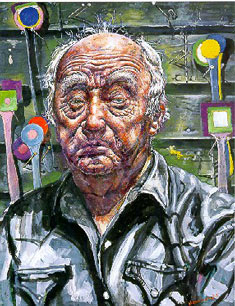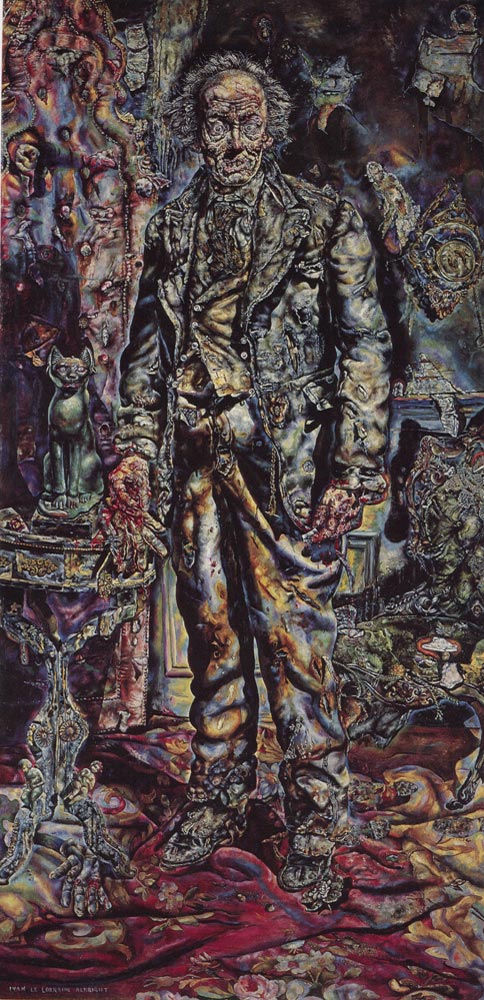| Ivan Albright | |
|---|---|
 |
|
| Born | Ivan Le Lorraine Albright Feb. 20, 1897 North Harvey, Illinois |
| Died | Nov. 18, 1983 (at age 86) Woodstock, Vermont |
| Nationality | American |
| Education | Art Institute of Chicago Pennsylvania Academy of the Fine Arts |
| Movement | Magic Realism |
| Field | Painting, Drawing, Poetry |
| Works | View Complete Works |
Ivan Le Lorraine Albright is known as an American artist whose creations are classified as the style of magic realistic. He is most renowned for self-portraits, still life, and character studies. Albright’s paintings are centered around life and death, the human spirit, and the effects of time. He wanted his style to respect and reflect his most admired artistic peers such as El Greco and Rembrandt, yet he was quick to develop his own style. Ivan Albright is revered as one of the twentieth-century’s most original artists.
Early Years and Influences
Ivan was born in North Harvey, Illinois, along with a twin brother Malvin Marr Albright. Their father was a landscape painter, who gave the twins middle names which reflected artists that he revered. Malvin and Ivan, who were inseparable, enrolled in The Art Institute of Chicago together, graduating in 1923. The boys flipped a coin, to decide who would study painting, and who would study sculpture.
Albright was very talented in several areas. While he was known for his paintings, he was also skilled in drafting, printmaking, and engraving. Ivan attended Northwestern University, dropped out, and then studied architecture at the University of Illinois. Ivan first worked in architecture and advertising briefly, but then returned to Illinois where he began painting seriously, achieving success, and had his first art showing in 1930. One of his early paintings The Lineman, won an award, making the cover of a magazine, but viewers complained that his image was unsettling.
 There were two possible influences of Albright’s painting themes. His preoccupation with the effects of time on the body and spirit, may have come from his work doing medical drawings for a hospital in France, during World War I. This morbid work made quite an influence on him, as did the Great Depression. The themes of his paintings reveal portraits where time is merciless, suggesting death or decay.
There were two possible influences of Albright’s painting themes. His preoccupation with the effects of time on the body and spirit, may have come from his work doing medical drawings for a hospital in France, during World War I. This morbid work made quite an influence on him, as did the Great Depression. The themes of his paintings reveal portraits where time is merciless, suggesting death or decay.
One of Albright’s most famous paintings, The Door (That Which I Should Have Done I Did Not Do), won a medal at three major exhibitions in Chicago, New York City, and Philadelphia in 1941. The Portrait of Dorian Gray became Albright’s most iconic images. The Albright twins were invited to create two paintings for Oscar Wilde’s film The Picture of Dorian Gray. Ivan’s chosen painting, depicts shocking realism, and the essence of his established notoriety.
Style and Medium
Magic realist art, is combining an American scene, with surrealist influences. Albright sought to portray mankind, and the horror of America during the War and the Great Depression. His paintings are realistic detail, portrayed in predominantly gray tones. His use of intricate detail and macabre realism sometimes shocks the viewer, but also leaves a lot to the imagination.
Albright’s style is defined as abstract, expressionist, modernist, and surrealist. Albright often used precise strokes with almost microscopic detail. Muted colors are used, and paired to look almost fluorescent. The loose brushstroke, with precise strokes of color injected were most often used. He used contrasts frequently, along with a discordant element. He often used background objects to challenge the viewer to focus on the portrait. Albright believed that there is constant tension, movement, and conflict between objects. Harmony in his portraits was not a goal. He hoped to disrupt and challenge the viewer.
It often took Albright years to complete a painting, due to his
precision. Often a brush with one hair was used to create an eyelash, or facial feature. Ivan never titled his art before it was completed and used poetic titles, which are sometimes shortened for reference purposes. He wanted to encourage the viewer to also imagine complex narratives for each work of art created.
Using paints and charcoal that he made himself, he would create elaborate sets in which to paint, and even carved his own intricate frames. Because he was particular to detail, his studio was painted black, and he wore black while creating a painting, to avoid any potential glare. Albright’s attention to details can be seen in such things as lace curtains, eyelashes, and even facial flaws such as wrinkles or blemishes on his subjects.
Goal
Ivan Albright (1897-1983) wanted to capture the uncanny realism of life. His paintings are like looking at a mundane aspect of life through a mysterious lens. He did not consider his works as portraying death, but as life, viewed honestly and clearly. His timeless themes were portrayed in twenty-five self-portraits from 1931-1983. His work The Widow took twenty-one years to complete, and he is deemed one of the most masterful art in his genre. Today, Ivan Albright’s creations can be seen at art museums in Illinois, New Hampshire, New York City, Washington D.C., and Britain.